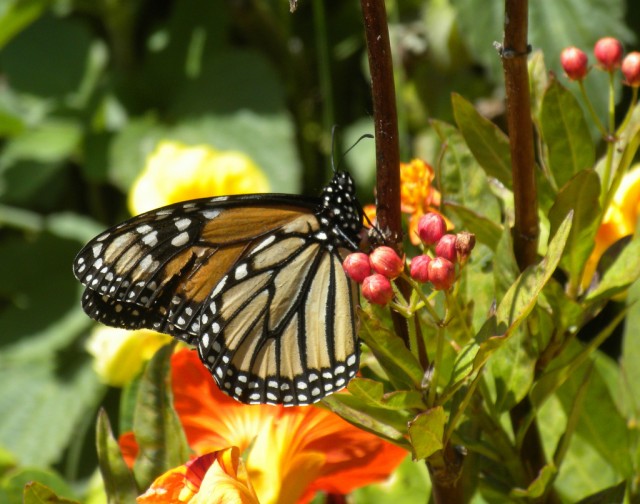The Monarchs are in trouble

I’ve been blogging about Monarch butterflies practically from the moment this blog began. I’ve been growing milkweed, the only host plant for monarch caterpillars, in our yard for over a decade—first in Crozet, Virginia, and then here in San Diego after our move seven years ago. When you leave a comment on this blog, if you don’t happen to have a WordPress avatar set up, the default avatar is a picture of milkweed from my garden. I made a very dopey video, once, showing some of our butterfly plants, and was lucky enough to catch a Monarch in the act of laying an egg on the underside of a leaf. We’ve been a family wrapped up in bees and butterflies for a very long time.
We had a fair number of caterpillars last year, enough to eat our five plants to the ground. But this year may be different.
This year, the giant Monarch migration that takes place in the mountains of Mexico has been, well, not exactly giant.
…for the first time in memory, the monarch butterflies didn’t come, at least not on the Day of the Dead. They began to straggle in a week later than usual, in record-low numbers. Last year’s low of 60 million now seems great compared with the fewer than three million that have shown up so far this year. Some experts fear that the spectacular migration could be near collapse.
The reasons aren’t a mystery:
A big part of it is the way the United States farms. As the price of corn has soared in recent years, driven by federal subsidies for biofuels, farmers have expanded their fields. That has meant plowing every scrap of earth that can grow a corn plant, including millions of acres of land once reserved in a federal program for conservation purposes.
Another major cause is farming with Roundup, a herbicide that kills virtually all plants except crops that are genetically modified to survive it.
As a result, millions of acres of native plants, especially milkweed, an important source of nectar for many species, and vital for monarch butterfly larvae, have been wiped out. One study showed that Iowa has lost almost 60 percent of its milkweed, and another found 90 percent was gone. “The agricultural landscape has been sterilized,” said Dr. Brower.
This article touches, too, on the dire plight of the honeybee, about which I’ve had much to say on this blog over the years.
I don’t often feel helpless. But with this, I do. What can I do beyond the small acts I’ve been doing? Planting milkweed, singing the joys of bee-and-butterfly gardening, avoiding pesticides and herbicides even though that means I have a weedy garden. Keep on singing, I guess?
